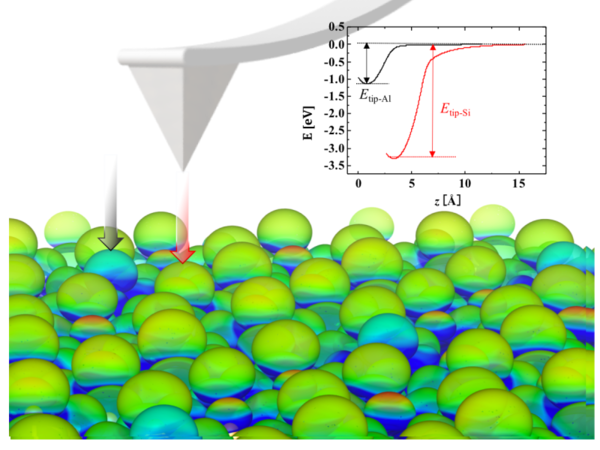A new insight into the characterisation of chemical properties of the elements has been contributed by a method of Czech and Japanese researchers, published in the prestigious journal Nature Communications. State-of-the-art scanning-probe microscopes already enable scientists to observe individual atoms on surfaces, but thanks to the new method, they can also measure the ability of these atoms to attract electrons, i.e. their electronegativity. This new method changes the existing definition of electronegativity and also opens the way to a deeper understanding of the nature of chemical bonds and chemical processes on the atomic level. The new findings could allow the control of chemical reactions in catalysis or biochemistry.
Electronegativity determines, among other things, the ability of an atom to interact with its environment and create chemical bonds. Until recently, scientists have been able to quantify it only using techniques that have worked with a large set of atoms. This situation has changed, due to the collaboration of scientists from the Regional Centre of Advanced Technologies and Materials (RCPTM) at Palacký University Olomouc, the Institute of Physics of the Czech Academy of Sciences, and the Universities of Tokyo and Osaka.
“The new method enables us, by means of atomic force microscopy, not only to determine the electronegativity of an atom on the surface of a solid, but also determine its dependence on the chemical environment of the measured atom. That was not possible before. We were able to carry out experimental measurements of the binding energies of individual surface atoms, supported by theoretical calculations. The detailed analyses showed how the chemical environment affects the electronegativity of the atom. This knowledge can be used for targeted management of chemical reactions,” said one of the authors, Pavel Jelínek, who is employed in RCPTM and the Institute of Physics of the Czech Academy of Sciences. This work extends the team’s own research published in 2007 in Nature magazine. The new method, however, overcomes the limitations of the original approach of chemical identification of atoms by making it possible to identify chemical elements with different electronegativity.
“We have shown that the current values of electronegativity of chemical elements are only valid for isolated atoms. Our method allows us to determine its changes, based on the chemical environment of the atom. This gives us a new, complex view of electronegativity and therefore we have to look a little differently at the characters of bonds in chemical compounds and on the chemical reactivity itself,” added Jelínek. In the periodic table of elements, the most electronegative halogens start with fluorine; the least electronegative are the alkaline earth metals.
According to RCPTM Director Radek Zbořil, this work may have substantial consequences in all areas associated with the character of chemical bonds and the course of chemical reactions. “I believe that a number of chemical principles that had been anticipated in the past and considered definitive will be gradually specified thanks to the unique possibility to look deeper into the structure of atoms and molecules by means of scanning microscopes,” said Zbořil.
The researchers have also demonstrated a characteristic linear relationship between the binding energies of surface atoms of different elements. Thus they demonstrated experimentally the validity of the equation proposed by Nobel Prize winner Linus Pauling for the polar covalent bond in the 1930s.
The observation of individual atoms in the structure of materials has been possible since the 1980s thanks to the discovery and development of the methodology of scanning tunnelling microscopy and atomic force microscopy. Only very recently have scientists been able to use these technologies to look into the structure and properties of molecules by means of specifically adjusted probes.
